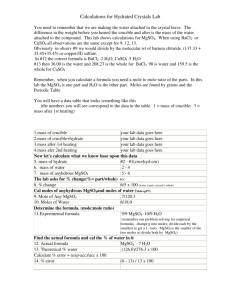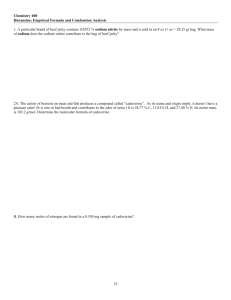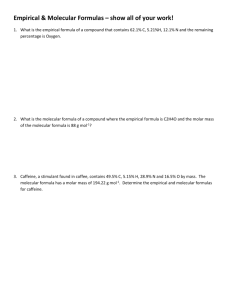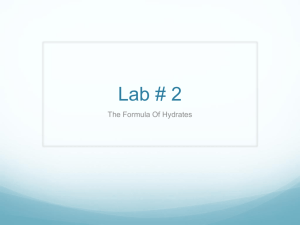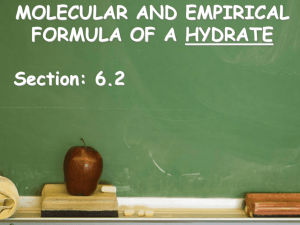Enthalpy of Hydration Experiment: Hess's Law & Calorimetry
advertisement
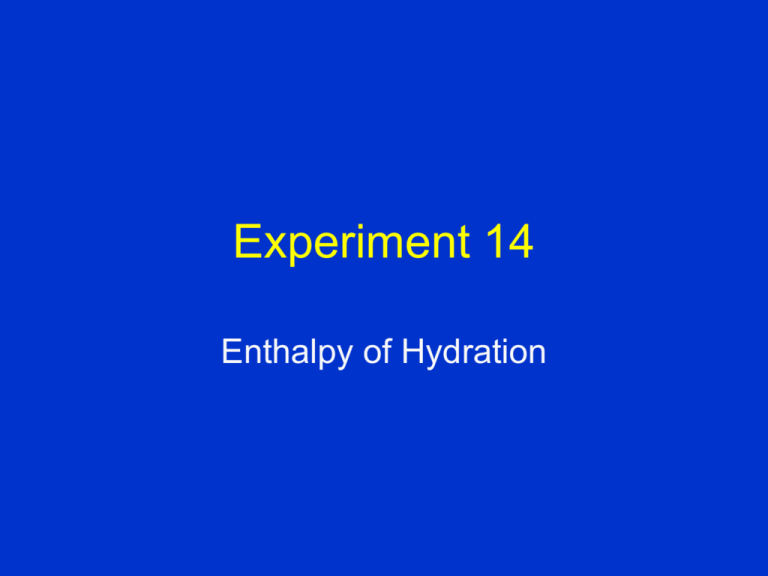
Experiment 14 Enthalpy of Hydration Purposes and Goals • The purpose of this experiment is to use Hess’s Law to determine the enthalpy change (ΔH) for the hydration of an anhydrous compound. Introduction • Conservation of energy • Hess’s Law of Heat Summation • Alternative view of Hess’s Law: ΔH does not depend on how I get from reactants to products. I can use this idea to determine ΔH for a reaction which is hard to study directly. Example: graphite diamond C(s, gr) C(s,di) A thermochemical cycle ΔH1 C(s,gr) + O2(g) ΔH2 C(s,di) + O2(g) CO2(g) ΔH3 DH1 = DH2 + DH3 • The direct conversion of graphite to diamond (corresponding to DH2) is hard to measure, but the two combustions (DH1 and DH3) are easy to measure. We can determine DH2 indirectly from DH1 and DH3. DH2 = DH1 - DH3 Your experiment ΔH1 MgSO4(s) + xs H2O(l) + 7 H2O(l) ΔH2 Mg2+(aq) + SO42-(aq) ΔH3 MgSO4. 7 H2O(s) + xs H2O(l) Calorimetry • Calorimetry---measuring heat flow • Fundamental idea: Qreaction = -Qsolution • Qsolution = C ΔT • C = (mass of solution) x (specific heat of the solution) Safety • Aprons and glasses • Thermometers are fragile and expensive; don’t use a thermometer as a stirring rod! Procedure • Work in pairs. • Needed equipment: 100-mL graduated cylinder, stirring rods, thermometers, 2 thermometer clamps, 2 calorimeter cups, ring stand, ring. • Same setup as Expt. 6 (CHEM 1031 lab). • One run with MgSO4, two with hydrate. • Weigh empty calorimeter cup. Record mass on data sheet. • Weigh solute (about 7.50 g of MgSO4, 15.35 g of hydrate). Idea: equal moles of solute in samples. • Add 100 mL water to cup; measure temperature every 30 seconds for five minutes. • Add MgSO4; use stirring rod (NOT THERMOMETER) to dissolve solute quickly. • Measure temperature every minute for fifteen minutes. After run is over, measure and record mass of cup plus solution. • Weigh second calorimeter cup; add water and measure temperature for five minutes as before. • After 5 minutes, add MgSO4. 7 H2O. Measure temperature for 15 minutes as before. Measure and record mass of cup and solution. • Discard solution (sink); add 100 mL of water and repeat run. After 5 minutes, add second portion of MgSO4. 7 H2O. Measure temperature for 15 minutes as before. Measure and record mass of cup plus solution; you will use the same mass of empty cup for both runs. Calculations • Draw a graph of temperature vs time for your experimental data. Each run is a separate graph. • Extrapolate the temperature lines before and after adding solute to the time at which solute was added. Typical Results MgSO4 36 temperature (C) 34 32 30 28 26 24 22 20 0 5 10 time (min) 15 20 Typical Results MgSO4.7H2O 22.5 temperature (C) 22 21.5 21 20.5 20 19.5 0 5 10 time (min) 15 20 DT = Tfinal – Tinitial • C = mass of solution x specific heat of solution (specific heat of solution = 3.837 J g-1 deg-1) • Qreaction = - C DT Qreaction DH moles_solute • (Good model: p. 14-3 of lab manual!) • Average DH values for solution of hydrate. ΔH1 MgSO4(s) + xs H2O(l) + 7 H2O(l) ΔH2 Mg2+(aq) + SO42-(aq) ΔH3 MgSO4. 7 H2O(s) + xs H2O(l) • You have calculated the heats of solution of MgSO4 (DH1 ) and of MgSO4. 7 H2O (DH3). • The enthalpy of hydration (DH2) is DH2 = DH1 - DH3.
